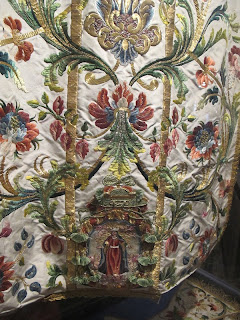In Briatico we are staying at Casa Sacro Cuore (Sacred Heart). We have a room with 5 beds and a balcony looking out over the Tyrrhenian Sea, but it is a long way down both to the free rocky beach or the sandy one which is payant!
Our excursion on Sunday was to Tropea settled by Greeks and used as a base by Scipio Africanus when he was having a go at Carthage. In earlier times it prospered, but today a lot of palazzos are deserted. The cathedral is Norman and it is a relief to see a plain simple interior. Apparently it did have a couple of hundred years as Baroque, but in the 1920s it was restored to its Norman appearance. It was a first communion service this morning and the congregation were very well dressed, but stilettoes and cobblestones do not mix.
Now on Monday we have been to Gerace. Italian roads are very well engineered. Today we went through a 3 km+ tunnel under the Aspromonte mountain range. We also drove a lot of narrow twisting mountain roads and Umberto our driver does a fantastic job and what is more he bought us genuine cleanskin wine for dinner tonight.
Gerace was settled in about the 9thC A.D. The people of Lorci, a settlement (originally Greek) on the coast were tired of being attacked by the Saracens (i.e. Turks, Tunisians etc.) and moved up into the hills. Gerace is a lovely old town although now only 3000 people live there, they have a choice of more than 20 churches. The cathedral was consecrated in 1045 and is Norman and Romanesque in style. They were into recycling even back then. They lugged columns from Roman and Greek villas and temples about 500m up the hill and incorporated them in the cathedral. The columns are various heights, so for some they had to dig pits to sit them in and others needed plinths to make the tops all the same height. Another nice touch in the cathedral is a new altar dedicated in 1995 by the Catholic archbishop and a Greek Orthodox Bishop from Venice.
The wild fennel by the road is huge and healthy.
Mature olive trees
Thought this was a gorgeous owl.
Quiet square in Altomonte
Prices for the use of a beach in Briatico
Sunset over the Tyrrhenian Sea
Part of a Norman doorway - Tropea cathedral
Unexploded Second World War bomb inside the cathedral. Our Lady of Romania did her bit to save the town.
Tropea is famous for sweet red onions.
Typical square in Tropea
One of the derelict palazzos.
Mt Stromboli from Capo Vaticano near Tropea
An enthusiastic folkloric troupe who entertained us on Sunday night.
An example of an elevated autostrada in Calabria. Such elevatedroads disrupt the local community less than other alternative construction.
Our guide Antonio with the key to the 13th C church of St Francis. No longer consecrated it was used as a prison by the French during World War II.
Detail from a fine 17thC marble marquetry altar in the church of St Francis
For my needleworking readers, detail of a chasuble in the cathedral of Gerace.
A square in Gerace - a good place for lunch.
The Cattolica in Stilo is a 9thC Byzantine church. Inside there are some fragments of early frescoes.
























I am loving reading your about your travels Kate. Fabulous photos as usual. Keep on enjoying.
ReplyDeleteAs I scrolled down through your photos, I kept thinking, "Oh, wow!", and then, "Oh, wow!" again at the next one. Repeat to end of post!
ReplyDeleteI have to correct you as to where Pythagoras set up his famous Pythagorean school. It was in Crotone where he set it up and not in Metapontum. He only died in Metapontum after being kicked out of Crotone years later by its citizens as many were against his teachings. Whoever said that he had a school there is wrong. Ask any ancient historian or read about it.
ReplyDelete